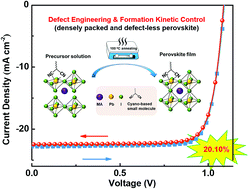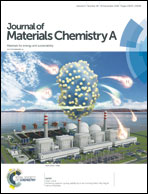Highly efficient planar perovskite solar cells achieved by simultaneous defect engineering and formation kinetic control†
Abstract
The formation of high quality (good morphology and low defect concentrations) perovskite films is crucial for realizing high-performance perovskite solar cells (PVSCs). Low-temperature processed perovskite films tend to have a high density of defect states, which hinder the enhancement of their device performance. Although various post-treatment methods have been reported to passivate the surface defects of perovskite, the critical issue is that defects inside the bulk film cannot be passivated simultaneously. Here, we demonstrate a new strategy of simultaneously controlling the perovskite formation kinetics and reducing the defects (e.g., unsaturated Pb) for achieving densely packed perovskite films with low defect concentrations. The strategy is realized through incorporating cyano-based small molecules into perovskite precursor. Our results show that the inverted planar-structured PVSCs with the perovskite films formed by the new strategy have significant performance improvement with PCE reaching 20.10%, which is among the highest values of low-temperature processed solar cells. This work provides a new strategy to further improve the quality of low-temperature processed perovskite films and the relevant device performances.



 Please wait while we load your content...
Please wait while we load your content...